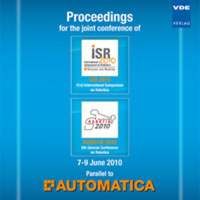Anticipation-Preprocessing for Object Pose Detection
Conference: ISR/ROBOTIK 2010 - ISR 2010 (41st International Symposium on Robotics) and ROBOTIK 2010 (6th German Conference on Robotics)
06/07/2010 - 06/09/2010 at Munich, Germany
Proceedings: ISR/ROBOTIK 2010
Pages: 6Language: englishTyp: PDF
Personal VDE Members are entitled to a 10% discount on this title
Authors:
Palzkill, Matthias; Ledermann, Thomas; Verl, Alexander (Fraunhofer IPA, Nobelstr. 12, 70569 Stuttgart, Germany)
Abstract:
This paper shows a new approach to significantly improve the runtime behaviour of existing object pose detection algorithms. The idea of anticipation-preprocessing is to reduce possible object poses up to a minimum by limiting the solution space. The assumption is that a smaller solution space comes along with a much faster evaluation. Anticipationpreprocessing starts with the most obvious features of sensory input. The treatment of features takes gestalt law of organization into account. Based on that, the procedure is to find new features and to keep recombining them. With the aid of the achieved feature sets a conclusion about a solution subspace can be drawn. Anticipation-preprocessing is inspired by human visual perception, whereof several theories exist. Comparing to one of the most famous by Marr (Vision, A computational investigation into the human representation and processing of visual information), memorization influences the entire process of the new approach and not just the final matching. The new approach was tested with an object pose detection algorithm called Coherent-Distance-Characteristics (abbr.: CDC). CDC Object Pose Detection is a view based approach which uses compact object description and still provides strong reliability. It has been originally developed for bin-picking applications by the authors. CDC works on spatial depth data. It was shown that the use of just one or two features already results in a runtime reduction of about 90 percent.


